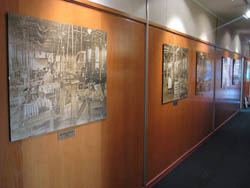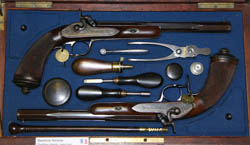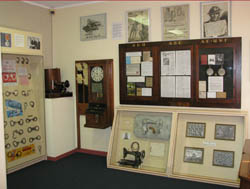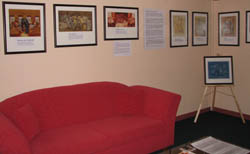Donations
- Donating items to the Museum
A brief history of the collection
Lithgow SAF over its years of operation built up an impressive reference collection of longarms and machine guns from all over the world. This collection, originally accumulated for technical appraisal, developed into a in-house 'museum' cared for by SAF staff. Public access to the collection was restricted on all but the rarest occasions.
In 1989 all Government defence industries were corporatised under the umbrella of Australian Defence Industries (later ADI Ltd) providing Australia with a single cohesive, profit-driven defence manufacturer.
The historical importance of the collection of small arms, commercial products, machinery and tooling of the Small Arms Factory was impressed upon ADI by a few ex-employees and community members. However, managing a museum was not part of ADIís brief, and therefore they agreed to gift the collection to the City of Lithgow in 1995.
The museum opened its doors to the public in October 1996 and is staffed completely by volunteers.
Glimpses of the Collection
The No 1 weapons

The No 1 cabinet contains first production weapons of Lithgow SAF.
On the top shelf is one of the few SMLE No 1 Mk III rifles manufactured in 1911 at the Pratt & Whitney factory in USA by Australian Factory foremen to prove the machinery destined for the Lithgow factory. Records indicate that 12 of these rifles were assembled from parts stamped with Commander Clarkson's personal 'C mark' stamp.
On the shelves below are the first Lithgow production weapons: the L1A1 SLR (serial no. AD5900001); F88 Austeyr
(serial no. SAF8800001); F1 carbine (serial no. AD6400001); and sectionised F89 Minimi light support weapon
(serial no. SW950001).
[back to contents]
Mt St Quentin statuette

Members of the Australian 2nd Division approached the factory in 1990 requesting a replica statuette of the original statue that stood atop the 2nd Division Memorial dedicated in 1925 at Mont St Quentin, France.
The statue depicting an Australian soldier bayoneting the German Eagle was torn down by the Germans during World War II when they once again invaded France, and was never seen again.
Working only from photographs of the original statue, three statuettes were produced by factory tradesmen. One was gifted to the people of Peronne and is housed in the Historial de la Grande Guerre (Museum of the Great War) in Peronne, France. The second statuette was kept by the 2nd Division who have since donated it to the Franco-Australian Museum in Villers-Bretonneux, and one was kept by the Lithgow Factory.
In 1971 a new statue was placed atop the memorial, this time with a less aggressive figure of an Australian digger with his head tilted downwards in quiet reflection.
[back to contents]
Experimental weapons
SAF Lithgow produced many experimental and prototype weapons.
During the fighting in New Guinea in World War II the Australian Army requested shorter and lighter weapons more suited to jungle warfare than the current production No 1 Mk III*. The Factory produced around 100 shortened and lightened No 1 weapons which proved unsuccessful during trials.
After the failure of the experimental shortened No 1, another 100 experimental rifles, the No 6 Mk 1 and the No 6 Mk 1/1were produced. (pictured top) These proved more successful during trials, however they were never adopted by the Australian Army, the war ending before production could begin.
Other experimental weapons produced by Lithgow SAF include the X1, X2 and X3, leading to the development of the F1 Carbine, and target rifles. The collection also contains rare prototypes manufactured in other countries, such as the British EM2 and a modified version of the Czechoslavakian ZB vz/33 manufactured for the pre-Bren gun trials in Britain. (pictured bottom)


[back to contents]
Photographs of early production sections

Panoramic photographs of the early factory sections are indicative of an era before Occupational Health and Safety. There was noise, spinning and flapping belts, swarf and dust, and no worker protection. Many fingers were lost and many an old factory worker later developed problems such as deafness and lung disease.
Every machine was driven from the overhead drive shafts by a whirring leather belt. It was a long way from the clinical enclosed machines of the modern era shown in photographs in the museum's upper hallway gallery.
[back to contents]
The Hayes handgun gallery
The evolution of the handgun makes a fascinating story. Technological changes and the ways different makers overcame common problems are displayed in the Hayes Handgun gallery.
Included are:
The rarities; the Borchardt, the 1904 Webley & Scott and Persian Contract Luger.
The unusual; the Chicago Palm Pistol
(pictured bottom), the Liberator and the Dardick.
And the beautiful; gold plated and hand-engraved presentation weapons and
cased duelling flintlocks.
This amazing collection features 800 plus handguns and ranges from the tiny Kolibri 2.7mm calibre pistol to the massive .500 Smith & Wesson Magnum revolver; the early flintlock and percussion weapons to modern day automatics.


[back to contents]
The SMLE 'rising sun' display

This magnificent display, inspired by the famous Australian Army 'Rising Sun' badge, shows every year of Lithgow production of the Rifle No 1 Mk III and Mk III* and its accompanying Pattern 07 sword bayonet.
Other rifles featured on the display are the experimental No 1 Shortened and Lightened, the 7.62 trials rifle based on the No 6, and a sectionised SMLE of the last year of manufacture (1956).
[back to contents]
The commercial display

The Factory's skilled employees were one of its most valuable assets.
To keep the skilled workforce intact during times of peace the Factory was empowered by the Government of the day, at times controversially, to take on commercial contracts.
These contracts ranged from rough forgings and investment castings to finished products. Some of the names found on factory production include Sunbeam (Mixmasters), Zircalloy (spanners), Pinnock (sewing machines), Slazenger (golf clubs), Borg Warner (gear boxes), Centrex (movie projectors) and SAF-LOK (handcuffs).
[back to contents]
No 1 Pinnock sewing machine

Tooling up for the manufacture of the Pinnock sewing machines began at Lithgow SAF in 1949 with production commencing in 1950. 6000 were made before production at Lithgow ceased in 1954. In 1957 Pinnock opened its own factory in Adelaide for sewing machine production.
The SAF-made machines were also branded as New Century, Gladiola, Thompson, Dobbie, Mercury, Kennedy and Hallmark and were decorated with transfers in patterns 'straight gold', 'laurel', 'fern', 'floral' or 'lion'. The patterns were not brand-specific. Any brand of machine could have any transfer pattern.
The first sewing machine made at Lithgow SAF pictured here (serial numbered A1), was presented back to the Factory in 1979 by the Pinnock family.
[back to contents]
The Brendorah paintings
During World War II when men heeded the call to war many women were employed at the Small Arms Factory. Heliodore (Dore) Hawthorne, an eccentric but talented artist, worked at the Small Arms Factory in the Bren Section from 1942 to 1945.
During her time at the factory Dore drew many sketches of scenes from the Factory and was later encouraged to produced a series of paintings from those sketches. These paintings, under the pseudonym "Brendorah", depicted the daily incidents of factory life and reflected her deeply felt commitment to social justice. The paintings were shown and sold in Lithgow and Sydney in two exhibitions entitled "Factory Folk".
A friend of Dore's, Nancy Hall, wrote in tribute "Dore felt the ugliness of materialism and pollution as keenly as she felt everything that was fine and beautiful and much of her painting and writing was a great cry of protest."
The museum's rest room displays Dore's story and prints of some of her works from her 'Factory Folk' series.


[back to contents]

